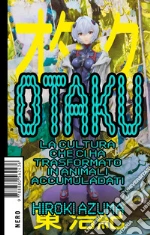 Libri di Hiroki Azuma su Unilibro.it
)
Libri di Hiroki Azuma su Unilibro.it
)
|
|
2024 |
 Title :
Otaku. La cultura che ci ha trasformato in animali accumuladati
Title :
Otaku. La cultura che ci ha trasformato in animali accumuladatiAuthor: Azuma Hiroki Publisher: Produzioni Nero Nato in Giappone e da lì diffusosi in tutto il mondo, il termine 'otaku' indica quella fascia di appassionati la cui intera esistenza ruota attorno al consumo maniacale di manga, anime, videogiochi e altri prodotti della cultura pop. In questo storico saggio, tra i più celebri della teoria critica nipponica, il filosofo Hiroki Azuma ne indaga le origini e le modalità di diffusione, per arrivare - grazie allo studio del culto sviluppatosi attorno a fenomeni quali Gundam, Neon Genesis Evangelion e Di Gi Charat - a tracciare il profilo di un nuovo soggetto, ormai protagonista della tarda modernità: l'«animale accumuladati», una forma di consumatore ossessionato dalla collezione e dalla catalogazione dei più disparati elementi presi da narrazioni sempre più stratificate, di cui la cultura otaku è al contempo avanguardia e rappresentazione terminale, anticipando l'attuale fan culture globale e gettando le basi delle cosiddette «estetiche di internet». € 20,00
Scontato: € 19,00
|
|
|
1914 |
 Title :
General Will 2.0
Title :
General Will 2.0Author: Azuma Hiroki, Person John (TRN), Matsuyama Naoki (TRN) Publisher: Vertical Inc The collective will and our social contract has changed the world's political landscape over the last year or so. Azuma looks back at Rousseau and Freud then forward to Twitter and Google to express how man deals with their part of the collective will through time. Azuma's challenges society's perceptions of general will by looking at three philosophies through time and techonology. A Look a Postmodern Society from one of Japan's leading critics and NY Times Editorial Contributor. Hiroki Azuma is Asia's prermier philosopher and literary critic. While he made a name for himself in academia with a look at the growth of technology through modern media, Azuma has looked at culture and humanity from a historical perspective as well describing Japan's cultural shift after the Tohoku Earthquake for the NY Times or revealing the power of social networking through Twitter and Google online and in the classroom. € 15,20
|
|
|
1911 |
 Title :
Beautiful Fighting Girl
Title :
Beautiful Fighting GirlAuthor: Tamaki Saito, Vincent J. Keith (TRN), Lawson Dawn (TRN), Azuma Hiroki (CON) Publisher: Univ of Minnesota Pr From Cutie Honey and Sailor Moon to Nausicaä of the Valley of the Wind, the worlds of Japanese anime and manga teem with prepubescent girls toting deadly weapons. Sometimes overtly sexual, always intensely cute, the beautiful fighting girl has been both hailed as a feminist icon and condemned as a symptom of the objectification of young women in Japanese society. In Beautiful Fighting Girl, Saitō Tamaki offers a far more sophisticated and convincing interpretation of this alluring and capable figure. For Saitō, the beautiful fighting girl is a complex sexual fantasy that paradoxically lends reality to the fictional spaces she inhabits. As an object of desire for male otaku (obsessive fans of anime and manga), she saturates these worlds with meaning even as her fictional status demands her ceaseless proliferation and reproduction. Rejecting simplistic moralizing, Saitō understands the otaku’s ability to eroticize and even fall in love with the beautiful fighting girl not as a sign of immaturity or maladaptation but as a result of a heightened sensitivity to the multiple layers of mediation and fictional context that constitute life in our hypermediated world—a logical outcome of the media they consume. Featuring extensive interviews with Japanese and American otaku, a comprehensive genealogy of the beautiful fighting girl, and an analysis of the American outsider artist Henry Darger, whose baroque imagination Saitō sees as an important antecedent of otaku culture, Beautiful Fighting Girl was hugely influential when first published in Japan, and it remains a key text in the study of manga, anime, and otaku culture. Now available in English for the first time, this book will spark new debates about the role played by desire in the production and consumption of popular culture. € 17,90
|
|
|
2009 |
 Title :
Otaku
Title :
OtakuAuthor: Azuma Hiroki, Abel Jonathan E. (TRN), Kono Shion (TRN) Publisher: Univ of Minnesota Pr Azuma (Center for the Study of World Civilizations, Tokyo Institute of Technology, Japan) philosophically explores the Japanese subculture of the otaku, which typically involves males between 18 and 40 who consume, produce, and collect comic books (manga), animated films (anime), and other products related to those forms of popular visual culture. He argues that the otaku provide a new model of postmodern consumer, the 'database animal,' whose ability to satiate themselves by cataloging, storing, and displaying characters from their stories is different from the 'human' mode of consumption that searches for deeper meaning in stories. Originally published in 2001 in Japanese as Dobutsuka suru posutomodan: otaku kara mita nihon shakai. Annotation ©2009 Book News, Inc., Portland, OR (booknews.com) € 16,10
|
 Title :
Otaku
Title :
OtakuAuthor: Azuma Hiroki, Abel Jonathan E. (TRN), Kono Shion (TRN) Publisher: Univ of Minnesota Pr € 57,40
|